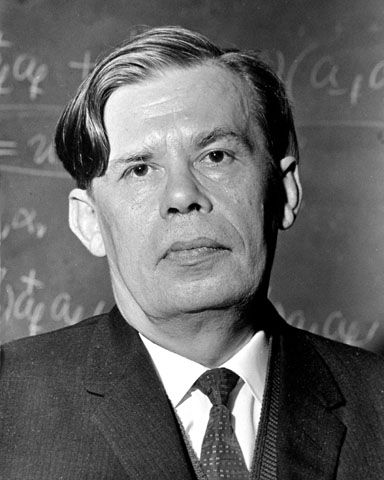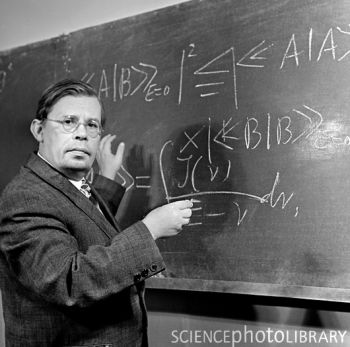<Back to Index>
- Physicist Nikolay Nikolaevich Bogolyubov, 1909
- Illustrator Aubrey Vincent Beardsley, 1872
- King of Portugal and the Algarves Afonso VI, 1643
PAGE SPONSOR


Nikolay Nikolaevich Bogolyubov (another spelling Bogoliubov, Russian: Никола́й Никола́евич Боголю́бов, Ukrainian: Микола Миколайович Боголюбов; 21 August 1909, Nizhny Novgorod – 13 February 1992, Moscow) was a Russian and Ukrainian Soviet mathematician and theoretical physicist known for significant contributions to quantum field theory, classical and quantum statistical mechanics, and to the theory of dynamical systems; a recipient of the Dirac Prize (1992).
Nikolay Bogolyubov was born on 21 August 1909 in Nizhny Novgorod, Russia, in the family of a priest of Russian Orthodox Church, teacher of theology, psychology and philosophy Nikolay Mikhailovich Bogolyubov and Ol'ga Nikolaevna, teacher of music. The Soviet Union regulations issued soon after the October Revolution in 1917 did not allow for children of priests to obtain a good education, and in 1921 the family of Nikolay Bogolyubov moved to Kiev, where these regulations were not implemented.
In Kiev Nikolay Bogolyubov began to actively study physics and mathematics. He attended research seminars in Kiev University and soon started to work under the supervision of the famous mathematician Nikolay Krylov. In 1924, at the age of 13, Nikolay Bogolyubov wrote his first published scientific paper On the behavior of solutions of linear differential equations at infinity. In 1925 he entered the Ph.D. program at the Academy of Sciences of Ukrainian SSR and obtained the degree of Kandidat Nauk (Candidate of Sciences, equivalent to Ph.D.) in 1928, at the age of 19, with the Ph.D. thesis On direct methods of variational calculus. In 1930, at the age of 21, he obtained the degree of Doktor nauk (Doctor of Sciences, equivalent to Habilitation), the highest degree in the Soviet Union, which requires to make a significant independent contribution to the sciences after the Ph.D..
This early period of Bogolyubov's work in science was concerned with such mathematical problems as direct methods of the calculus of variations, the theory of almost periodic functions, methods of approximate solution of differential equations, and dynamical systems. This earlier research had already earned him wide recognition. One of his essays was awarded the Bologna Academy of Sciences Prize in 1930, and the author was awarded the erudite degree of doctor of mathematics '. This was the period when the great scientific rise of the young Nikolai Bogolyubov began, later producing new multiple scientific trends in modern mathematics, physics, and mechanics.
Since 1931, Krylov and Bogolyubov worked together on the problems of nonlinear mechanics and nonlinear oscillations. They were the key figures in the "Kiev school of nonlinear oscillation research", where their cooperation resulted in the paper "On the quasiperiodic solutions of the equations of nonlinear mechanics" (1934) and the book Introduction to Nonlinear Mechanics (1937; translated to English in 1947) leading to the creation of the large field of non-linear mechanics.
And this can explain, as the authors believe, the need to shape the collection of problems of non-linear perturbation theory into a special science, which could be named NON-LINEAR MECHANICS.
– N. M. Krylov and N. N. Bogolyubov, New methods in non-linear mechanics, ONTI GTTI, Moscow-Leningrad, 1934
Distinctive features of the Kiev School approach included an emphasis on the computation of solutions (not just a proof of its existence), approximations of periodic solutions, use of the invariant manifolds in the phase space, and applications of a single unified approach to many different problems. From a control engineering point of view, the key achievement of the Kiev School was the development by Krylov and Bogolyubov of the describing function method for the analysis of nonlinear control problems.
In the period 1928 - 1973, Nikolay Bogolyubov worked in the Institute for Theoretical Physics of the National Academy of Sciences of Ukraine holding the position of the Director of the institute since 1965. He lectured in the Kiev University in the period 1936 - 1959.
After the German attack against the Soviet Union on 22 June 1941 (beginning of the Great Patriotic War),
most institutes and universities from the west part of Russia were
evacuated into east regions far from the battle lines. Nikolay
Bogolyubov moved to Ufa, where he became Head of the Departments of Mathematical Analysis at Ufa State Aviation Technical University and at Ufa Pedagogical Institute, remaining on these positions during the period of July 1941 – August 1943. In
autumn 1943, Bogolyubov came from the evacuation to Moscow and on 1
November 1943 he accepted a position in the Department of Theoretical
Physics at the Moscow State University (MSU). At that time the Head of the Department was Anatoly Vlasov (for a short period in 1944 the Head of the Department was Vladimir Fock). Theoretical physicists working in the department in that period included Dmitry Ivanenko, Arsenij Sokolov, and other famous physicists. In the period 1943 – 1946, Bogolyubov's resesarch was essentially concerned with the theory of stochastic processes and asymptotic methods. In his work, a simple example of an anharmonic oscillator evolving
under the force of the form as a superposition of incoherent sinusoidal
oscillations with continuous spectrum was used to show that depending
on a specific approximation time scale the evolution of the system can
be either deterministic, or a stochastic process satisfying the Fokker - Planck equation,
or even a process which is neither deterministic nor stochastic. In
other words, he showed that depending on the choice of the time scale
for the corresponding approximations the same stochastic process can be
regarded as both dynamical and Markovian,
and in the general case as a non-Markov process. This work was the
first to introduce the notion of time hierarchy in non-equilibrium
statistical physics which then became the key concept in all further
development of the statistical theory of irreversible processes. In
1945, Bogolyubov proved a fundamental theorem on the existence and
basic properties of a one - parameter integral manifold for a system of
non-linear differential equations. He investigated periodic and
quasi - periodic solutions lying on a one - dimensional manifold, thus
forming the foundation for a new method of non-linear mechanics, the method of integral manifolds. In 1946, he published in JETP two works on equilibrium and non-equilibrium statistical mechanics which became the essence of his fundamental monograph Problems of dynamical theory in statistical physics (Moscow, 1946). On
26 January 1953, Nikolay Bogolyubov became the Head of the Department
of Theoretical Physics at MSU, after Anatoly Vlasov decided to leave
the position on January 2, 1953. In 1947, Nikolay Bogolyubov organized and became the Head of the Department of Theoretical Physics at the Steklov Mathematical Institute. In 1969, the Department of Theoretical Physics was separated into the Departments of Mathematical Physics (Head Vasily Vladimirov), of Statistical Mechanics, and of Quantum Field Theory (Head Mikhail Polivanov).
While working in the Steklov Institute, Nikolay Bogolyubov and his
school contributed to science with many important works including works
on renormalization theory, renormalization group, axiomatic S-matrix theory, and works on the theory of dispersion relations. In the late 1940s and 1950s, Bogoliubov worked on the theory of superfluidity and superconductivity, where he developed the method of BBGKY hierarchy for
a derivation of kinetic equations, formulated the microscopic theory of
superfluidity, and made other essential contributions. Later he worked
on quantum field theory, where he introduced the Bogoliubov transformation, formulated and proved theBogoliubov's edge-of-the-wedge theorem and Bogoliubov - Parasyuk theorem (with Ostap Parasyuk), and obtained other significant results. In the 1960s his attention turned to the quark model of hadrons; in 1965 he was among the first scientists to study the new quantum number color charge. In 1946, Nikolay Bogoliubow was elected as a Corresponding Member of the USSR Academy of Sciences. In 1948, he became Academician of the National Academy of Sciences of Ukraine and in 1953 Academician of the USSR Academy of Sciences.
Since 1956, he worked in the Joint Institute for Nuclear Research (JINR), Dubna, Russia, where he was a founder (together with Dmitry Blokhintsev) and the first director of the Laboratory of Theoretical Physics.
This laboratory, where Nikolay Bogolyubov worked for a long time, has
traditionally been the home of the prominent Russian schools in quantum field theory, theoretical nuclear physics, statistical physics, and nonlinear mechanics. Nikolay Bogolyubov was Director of the JINR in the period 1966 - 1988.
His son Nikolay Boglyubov (jr) is a theoretical physicist working in the fields of mathematical physics and statistical mechanics. Nikolay Bogolyubov was a recipient of various highest USSR honors and international awards, including Stalin Prize (1947, 1953), USSR State Prize (1984), Lenin Prize (1958), Heineman Prize for Mathematical Physics (1966), Hero of Socialist Labor (1969, 1979), Max Planck medal (1973), Franklin Medal (1974), The Lomonosov Gold Medal (1985), Dirac Prize (1992). The Joint Institute for Nuclear Research awards two prizes in memory of Nikolay Bogolyubov: The Bogolyubov Prize for scientists with outstanding contribution to theoretical physics and applied mathematics and the Bogolyubov Prize for young scientists. The National Academy of Sciences of Ukraine awards the Bogolyubov Prize for scientists with outstanding contributions to theoretical physics and applied mathematics. The central street of Dubna is named in the memory of Nikolay Bogolyubov as Bogolyubov prospect (Russian: проспект Боголюбова). In
2009, the 100th anniversary of the birth of Nikolay Bogolyubov was
celebrated with two conferences organized in the memory of Nikolay
Bogolyubov in Russia and Ukraine: Fundamental
works of Nikolay Bogoliubov were devoted to asymptotic methods of
nonlinear mechanics, quantum field theory, statistical field theory,
variational calculus, approximation methods in mathematical analysis,
equations of mathematical physics, theory of stability, theory of
dynamical systems, and to many other areas. He built a new theory of scattering matrices, formulated the concept of microscopical causality, obtained important results in quantum electrodynamics, and investigated on the basis of the edge-of-the-wedge theorem the
dispersion relations in elementary particle physics. He suggested a new
synthesis of the Bohr theory of quasiperiodic functions and developed
methods for asymptotic integration of nonlinear differential equations
which describe oscillating processes.
Nikolay Bogoliubov was a scientific supervisor of Yurii Mitropolskiy, Dmitry Shirkov, Selim Krein, Iosif Gihman, Tofik Mamedov, Kirill Gurov, Mikhail Polivanov, Naftul Polsky, Galina Biryuk, Sergei Tyablikov, Dmitry Zubarev, Vladimir Kadyshevsky,
and many other students. His method of teaching, based on creation of a
warm atmosphere, politeness and kindness, is famous in Russia and is
known as the "Bogoliubov approach".